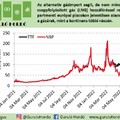What’s such a big deal about a self-driving car, when you even have to give up control of the vehicle? Exactly that. You might not need to own a car at all, and still get everywhere like you had a chauffeur. And it may even change how much your house is worth, for example.
A self-driving car could be thought of as an innovation similar in its effect to making chauffeured cars available on demand, for everyone, at a cheap price. The life of the average citizen would in some ways get closer to that of those who already use chauffeurs. The consequences are wide-ranging, potentially affecting settlement structures, car ownership and industry, mass transportation, traffic rules, or even pedestrian behavior.
![tumblr_mmud9rSgnc1qjpj4co1_500[1].jpg](https://m.blog.hu/gu/gurulohordo/image/tumblr_mmud9rSgnc1qjpj4co1_500%5B1%5D.jpg) Your new yellow cab? Source: jonberkeley.tumblr.com
Your new yellow cab? Source: jonberkeley.tumblr.com
Self-driving cars would boost car use. The very old and the very young, who cannot drive and so far could not afford taxis, would use cars a lot more. You could do online shopping, and send your car to the supermarket where it is loaded. Long-distance commutes would become more popular – you could sleep, work, read, watch TV or do whatever you like while commuting. You could do car round-trip holidays, spending the night sleeping and travelling, exploring a new location every day. New business and distribution models are likely to spring from this. Some jobs, like taxi drivers, would disappear, while others would come into existence.
Cars could largely replace public transport. Today, the main reason why people wait for the bus or a tram is that taxis are more expensive. But a large part of that price is the wage for the driver (also for the time he or she spends waiting for a fare). If a self-driving taxi is available immediately, and it is cheap, most people would opt for that. It is most likely that “taxi” pricing would be dynamic, consisting of fuel cost plus a premium for scarcity in busy times. But as with airlines, in slow periods the premium could drop to close to zero, or even negative (if you are prepared to watch commercials while travelling). Parking would no longer be a problem in cities either, since you could send your car away for parking somewhere less crowded.
![self-driving-cars[1].jpg](https://m.blog.hu/gu/gurulohordo/image/self-driving-cars%5B1%5D.jpg) Forget traffic lights and jams? Source: geekologie.com
Forget traffic lights and jams? Source: geekologie.com
Traffic management could change as well, potentially boosting the capacity of existing roads. Cars could update traffic conditions in real-time and route themselves on less congested roads. If all the cars have self-driving mode, and can communicate with each other, you may not need traffic lights in cities – cars could slip into the gap between other cars in the cross street. The experience would probably be frightening at first, but so was flying, and people can get used to frightening things surprisingly fast. In longer distance travel, cars could drive very close to each other in large convoys, saving fuel and space. In certain areas, non-self-driving cars may be completely banned in the future, or you would have to pay a large premium for using them, slowing down other traffic.
Inner cities could become nicer places with less congestion, more space (no parking cars), less pollution (more efficient traffic management). The traditional pattern may even reverse, and people with kids could move back to city centers. But as commuting becomes cheaper and less of a trouble, the premium on inner city real estate could nevertheless decline. A more mobile labor force could reduce regional unemployment rates. If people can live anywhere, there would be more competition among settlements, and people would move to places that are well run and in a pleasant environment. So probably the price of real estate in selected, well managed countryside settlements could increase.
Self-driving cars will probably change car ownership as well. Currently, car ownership is very inefficient: private cars are typically not used about 95% of the time, and a large amount of capital just sits there. They are also inefficient in a sense that the same car is used for the daily commute, the shopping trip and the family holiday. If you don’t own a car, you could rent the right type when you want it, delivered to your door. Some people would still prefer owning, especially if they have a bed built in for the morning commute or the long distance trip, but car ownership would probably drop steeply – it would be a lot cheaper to rent. This model could spread faster in places like China, where car ownership is not yet entrenched, but which are at the phase of increasing motor vehicle use.
Google recently said it will build its own self-driving cars, failing to agree with manufacturers. Uber, a car rental and taxi upstart (in which Google is an investor) will buy 2,500 of these cars. Shortly after these news came out, Nissan promised to bring self-driving cars to the consumer market by 2020. It is only a question of time when self-driving cars become a reality, and 2020 looks like becoming an “anchor” for expectations: BMW, Audi and GM all target/forecast this date for the general availability of driverless models. We wrote about self-driving cars in this earlier post.
Source: newyorker.com
If car use increases, but the number of cars potentially drops, there would be a lot higher yearly running of individual cars, and a higher turnover of the car stock as well. Individual cars would be replaced more often. This would foster innovation among car manufacturers, and would force them to use more flexible production methods to satisfy quickly changing fads and fashions. Another solution would be to build modular, transformable cars, where the size of the car or the engine can be changed as demand requires – making cars larger for the weekends, for example.
In terms of motor fuel demand, higher car use at the face of it would increase oil demand. But given the faster turnover of the car stock, more fuel efficient cars would spread faster. Also, using more expensive electric cars would not be such a burden if you are renting and the capital does not have to sit there idle most of the time. Why not impress with the newest Tesla electric sports car if it is affordable? Overall fuel consumption may even decline...
Finally, if most cars are self-driving, traffic accidents would likely become nearly non-existent (caused probably by the action of the remaining human drivers). Currently more than 1 million people die in traffic accidents globally each year. It’s one of the world’s top 10 causes of death. Insurance premiums could drop. Cars could be smaller and lighter if there is no accident risk.
In fact it is likely that cars would be very protective of pedestrians and cyclists too, stopping if they are in their paths. And that would of course lead to pedestrians and cyclists becoming very casual about where and when they go or cross a road, forcing cars to abruptly stop all the time. Possibly new traffic rules would be needed to adapt to these and other changes.
Of course we cannot forecast all the changes that self-driving cars would cause, there are likely to be a lot more. And then we have not even talked about the potential of flying-self-driving cars… All this is just one facet of the “rise of the robots”, which will change many other areas of life. Sit back and enjoy what surely will be an interesting ride…
![130509142450-flying-car-tfx-terrafugia-story-top[1].jpg](https://m.blog.hu/gu/gurulohordo/image/130509142450-flying-car-tfx-terrafugia-story-top%5B1%5D.jpg) Source: CNN.com
Source: CNN.com
A bejegyzés trackback címe:
Kommentek:
A hozzászólások a vonatkozó jogszabályok értelmében felhasználói tartalomnak minősülnek, értük a szolgáltatás technikai üzemeltetője semmilyen felelősséget nem vállal, azokat nem ellenőrzi. Kifogás esetén forduljon a blog szerkesztőjéhez. Részletek a Felhasználási feltételekben és az adatvédelmi tájékoztatóban.

![self-driving-car-465[1].jpg](https://m.blog.hu/gu/gurulohordo/image/self-driving-car-465%5B1%5D.jpg)



